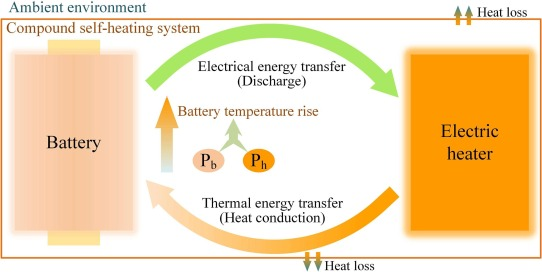|

| 摘要: Rapid and effective battery preheating for thermal management is particularly significant to overcome the performance limitation of batteries and guarantee the efficient operation of electric vehicles in cold environments. A low-temperature compound self-heating (CSH) strategy integrating the inner-battery direct-current heating and outer-battery electric heating is proposed to enhance heating efficiency and shorten heating duration without the requirement of extra power supplies. Computationally efficient distributed thermal equivalent circuit models, to capture the temperature distribution within batteries, are developed and experimentally validated with good accuracy. Four typical CSH methods are systematically discussed and compared in terms of the heating rate, temperature uniformity, energy consumption, capacity fade, and fabrication and safety challenge. The CSH method with electric heaters installed on the largest battery surfaces is found preferable due to its relatively easy implementation and low safety risk, and slightly small temperature gradient within the battery. Three crucial yet competing objectives, the heating time, temperature gradient, and capacity fade, are formulated for the favorable CSH method, and the Pareto front is obtained using the multi-objective optimization algorithm. An optimal low-temperature CSH method is thus proposed, where the battery is heated from ?30 °C to 2 °C within 62.1 s. Compared with the direct-current heating method, the proposed optimal CSH method strengthens the heating rate by 60.8%, reduces energy consumption by 54.8%, and relieves battery degradation by 45.2%. |
部分图片:
| | 
图1 Experimental platform for heating tests and model parameter identification. Heating test I and II are used to identify the DTEC model parameters along the thickness and length direction, respectively. | 
图2 The schematic diagram of low-temperature compound self-heating system for LIBs integrating the inner-battery DC heating and outer-battery EH heating without the requirement of additional power supplies. The electrical energy transfer and the thermal energy transfer seem to form a closed-loop system for energy transfer, to warm the LIB up simultaneously using both the internal heat and the heat transferred from the EH, achieving rapid and efficient heating. | 引文信息: H. Ruan, B. Sun, T. Zhu, X. He, X. Su, A. Cruden, W. Gao, Compound self-heating strategies and multi-objective optimization for lithium-ion batteries at low temperature, Applied Thermal Engineering. 186 (2021) 116158. https://doi.org/10.1016/j.applthermaleng.2020.116158.(下载链接)
| 其他相关论文: 1. S. Wu, R. Xiong, H. Li, et al. The state of the art on preheating lithium-ion batteries in cold weather. J. Storage Mater., 27 (2020), Article 101059(下载链接) 2. S. Guo, R. Xiong, W. Shen, et al. Aging investigation of an echelon internal heating method on a three-electrode lithium ion cell at low temperatures. J. Storage Mater., 25 (2019), Article 100878(下载链接)
|
|